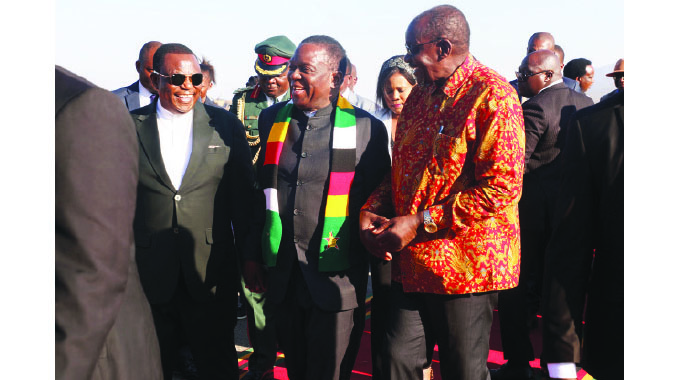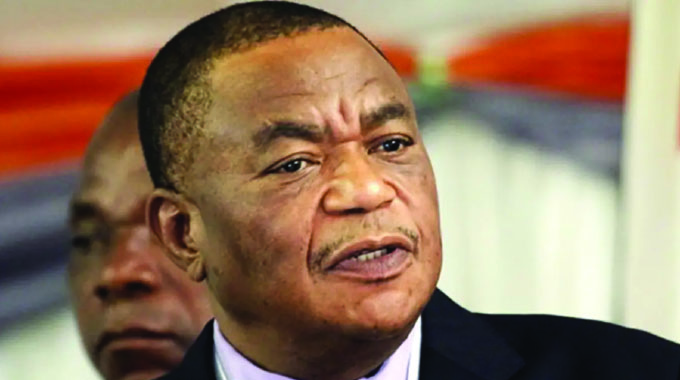RBZ unveils new currency

Golden Sibanda
Business News Editor
RESERVE Bank of Zimbabwe (RBZ) Governor, Dr John Mushayavanhu, yesterday unveiled the country’s new medium of exchange, the Zimbabwe Gold (ZiG), as part of several policy measures to address exchange rate volatility, curtail inflation and restore macro-economic stability.
Presenting his inaugural Monetary Policy Statement (MPS) in Harare, the new central bank chief said the apex bank was recalibrating its monetary policy framework to address the current state of price and exchange rate instability in the economy.
He said the policy stance was informed by two strategic pillars of restoring price and exchange rate stability and remonetising the local currency to serve its role as a medium of exchange and a store of value.
The latest policy framework, he said, sought to rebuild market confidence and trust, as well as bank policy credibility.
Committing to observe strict adherence to rules and discipline, Dr Mushayavanhu praised the previous efforts of the Government and central bank, saying they had made significant strides in sustaining an optimal currency mix in the multi-currency system.
He noted that exchange rate and inflation volatilities experienced in the economy continued to threaten the prospects of the local currency under the multi-currency system, hence the coterie of proposed new measures in the MPS, including the new structured currency.
Dr Mushayavanhu defined “structured currency” as a currency “pegged to a specific exchange rate or currency basket and backed by a bundle of foreign exchange assets potentially including gold”.
“The Reserve Bank is introducing a structured currency, which is generally defined as a currency that is pegged to a specific exchange rate or currency basket and backed by a bundle of foreign exchange assets (potentially including gold).
“This means that a Central Bank can only issue domestic notes and coins when fully backed by a foreign “reserve” currency or foreign exchange assets and that the currency is fully convertible into the reserve currency on demand.
“The structured currency being introduced is anchored by a composite basket of currency and precious metals (mainly gold) held as reserves for this purpose by the Reserve Bank.”
The central bank Governor noted that exchange rate volatility, which has driven rapid inflation increase in the country, was caused by high demand for foreign currency as a store of value, reduced confidence due to continued currency volatility, the widening margin between the interbank and parallel market exchange rates, reduced use of the local currency for domestic transactions and lack of certainty and predictability on the exchange rate front.
Dr Mushayavanhu said the domestic economy had lately been moving towards full dollarisation, with over 80 percent of market transactions now conducted in US dollars.
“Public outcry over excessive bank charges, problem of change, rejection of soiled US dollar notes and inconvenience of small Zimbabwe dollar denominations, has rendered the Zimbabwe dollar ineffective as a store of value and means of exchange,” he said.
Increased demand for local currency will enhance its stability and role as a store of value and medium of exchange, the Governor opined.
The ZiG has, therefore, replaced the inflation-weary Zimbabwe dollar, which had fallen to about $33 000/US$1 on the interbank market as of Friday and traded above $40 000/US$1 on the open market.
Statutory Instrument 60 of 2024 was issued yesterday to give effect to the new currency changes.
The SI, issued in terms of Presidential Powers (Temporary Measures) (Zimbabwe Gold Notes and Coins), Regulations, 2024, amends The Reserve Bank of Zimbabwe Act (Chapter 20:15) (Number 5 of 99) to give effect to the new currency changes.
Dr Mushayavanhu noted that Statutory Instrument 218 of 2023 restored the use of multicurrency in the settlement of any transactions until December 31, 2030. As such, he said the bank would prepare a structured roadmap to gradually promote the increased use of the new local currency as the nation moves towards 2030.
All Zimbabwe dollar balances will thus be converted to ZiG at the ruling official rate. Dr Mushayavanhu said the ZiG will have a starting exchange rate of 13,56 to the US dollar.
Thereafter, the willing buyer willing seller interbank market exchange rate will be used to convert into the country’s newly introduced structured currency.
“With effect from April 5, 2024, banks shall convert the current Zimbabwe dollar balances into the new currency, which shall be called Zimbabwe Gold (ZiG) to foster simplicity, certainty and predictability in monetary and financial affairs,” the Governor said.
The new currency will co-circulate with other foreign currencies in the economy, Dr Mushayavanhu said.
“The swap rate will be guided by the closing interbank exchange rate and the price of gold as at April 5 2024.
The swap rate shall be used to make legitimate conversions of all Zimbabwe dollar deposits in the banking sector.
Consequently, all Zimbabwe dollar loans and advances made by the sector, Treasury bills, outstanding auction allotments, export surrender obligations, prices of goods and services in Zimbabwe and any other Zimbabwe-denominated obligations, would be converted to ZiG.
On conversion of all current Zimbabwe dollar balances, local banks have been directed to rename all the current local currency accounts as ZiG accounts.
Gold-backed Digital Token (GBDT) accounts will no longer be called ZiG accounts but will be known as GBDT accounts and remain only as investment instruments.
“All Zimbabwe dollar notes and coins held by account holders will be credited into their ZiG accounts using the applicable conversion factor. The banks will continue to accept these deposits for 21 days after 5 April 2024.
Dr Mushayavanhu said the Reserve Bank had made special arrangements for those without bank accounts to swap their Zimbabwe dollar notes and coins at POSB and AFC Commercial Bank within 21 days after April 5, 2024.
The introduction of the new structured currency requires the issuance of new banknotes to facilitate transactions in the economy, whilst maintaining the Bank’s policy of a cash-lite economy, the Governor said.
“These notes shall be issued gradually in the market to cater for small transactions and to ensure the availability of change, thus, mitigating the use of retail vouchers in the local economy. As such, the proposed denominations will bring convenience to the transacting public,” Dr Mushayavanhu said.
Accordingly, ZiG notes and coins shall be issued in denominations made up of 1ZiG, 2ZiG, 5ZiG, 10ZiG, 20Zig, 50ZiG, 100ZiG, and 200ZiG, which will be distributed through the usual normal banking channels and, will be fully covered by the quantity and value of gold and foreign currency held as reserves.
The currency denominations are also informed by the intervening exchange rate of the ZiG to the US dollar.
ZiG shall at all times be anchored and fully backed by a composite basket of reserves comprising foreign currency and precious metals (mainly gold), received by the RBZ, as part of in-kind (physical mineral) royalties and kept in the vaults of the bank.
Dr Mushayavanhu said foreign currency balances would be accumulated through market purchases from the 25 percent surrender requirements as well as sale of some precious metals received as royalties.
As of April 5, 2024, the bank has reserve assets of US$ 100 million in cash and 2,522 kgs of gold (US$185 million) to back the entire local currency component of reserve money which currently stands at $2,6 trillion requiring full (100 percent) cover of gold and cash reserves amounting to US$90 million.
The gold and cash reserve holdings currently with the bank represent more than three times the total amount of the local currency being issued.
Dr Mushayavanhu said the central bank would ensure strict adherence to the statutory limit on bank lending to the Government, ensuring that the quantum of reserve money is fully backed by the equivalent, gold and foreign currency reserves and maintaining a tight monetary policy stance to ensure the sustainability of the monetary anchor.
The bank would also ensure that up to 50 percent of the liquidated surrender forex receipts are channeled to support the forex market, while retaining the balance to meet Government foreign currency needs.
Further, the apex bank would implement strict liquidity management to smoothen liquidity shocks that cause spikes in the exchange rate, put measures to ensure continued fostering of super demand for the local currency by the Government through the mandatory requirement for companies to settle at least 50 percent of their tax obligations on Quarterly Payments Dates (QPDs) in ZiG.
Notwithstanding the new currency arrangement, Dr Mushayavanhu said, the effective management of liquidity in the market remained key in stabilising the exchange rate and inflation.
The central bank chief said the bank would use 50 percent of the foreign currency proceeds from surrender requirements for strategic interventions in the foreign exchange interbank market.
“The remaining foreign currency will be available to satisfy the Government’s foreign currency obligations in exchange for ZiG and to build foreign exchange reserves for the Reserve Bank of Zimbabwe.
“Foreign currency retention thresholds remain standardised at 75 percent across all sectors, except for small-scale gold producers,” the Governor said.
Under his stewardship, Dr Mushayavanhu said there would be no sacred cows or special treatment of economic players in terms of export earnings surrender thresholds.
The bank has recalibrated the bank policy rate from 130 percent per annum to 20 percent per annum consistent with the new monetary policy framework.
The overnight accommodation interest rate has been set at 5 percent above the bank policy rate and the bank deposit facility interest rate at 7,5 percent below the bank policy rate, thus giving the starting interest rate corridor of between 11 percent and 25 percent per annum.
During his tenure, Dr Mushayavanhu said he would not allow any quasi-fiscal activities, which in the past have been blamed for driving liquidity and driving inflation.
Cognisant of calls by the banking public for affordable and reasonable bank charges, the RBZ Governor said the central bank was, with immediate effect, directing all banking institutions to put exemption clauses on monthly maintenance or service charges for both foreign currency accounts and ZiG deposit accounts that maintain a consecutive minimum daily balance of US$100 and below or its equivalent in ZiG for a period of up to 30 days.
Dr Mushayavanhu delivered the 2024 MPS in the presence of several senior officials of the apex bank, including Deputy Governor Dr Innocent Matshe, RBZ chairman Edwin Manikai, outgoing Governor Dr John Mangudya, who attended to show moral support to his successor, as well as Finance, Economic Development and Investment Promotion Deputy Minister David Mnangagwa.









Comments